Newsletter

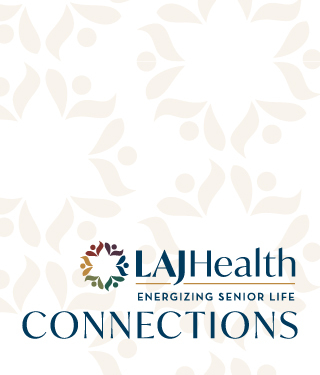
Our Newsletter
Connections
Mar
6
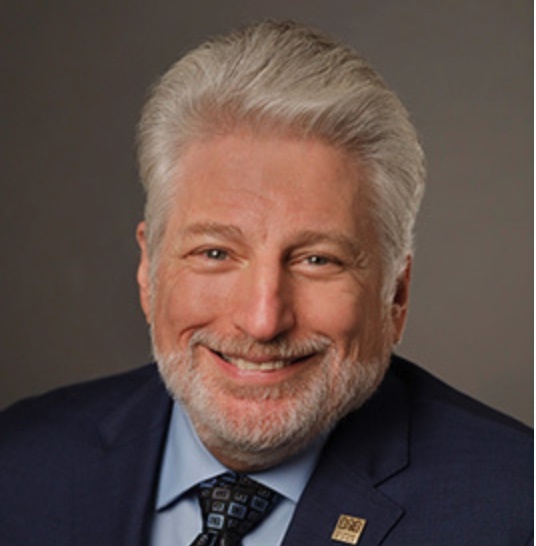
An important message on the Coronavirus from Dr. Marco
COVID-19, a strain of the Coronavirus, has recently been in the news. The Los Angeles Jewish Home (LAJH) and all of its programs have no identified threat at this time. Currently, there are only a handful of cases in our city, but that is likely to change. Our leadership team is staying abreast of the situation and monitoring communications from the government programs that advise health care institutions.
On March 4, 2020, the Centers for Medicare and Medicaid Services (CMS) announced “Actions to Address Spread of Coronavirus.” CMS announced several actions aimed at limiting the spread of the Novel Coronavirus 2019 (COVID-19). Specifically, CMS issued a call to action to health care providers across the country to ensure they are implementing their infection control procedures. The LAJH has answered that call. We are maintaining and supplementing our infection control procedures.
Our priority remains the protection from harm of the most vulnerable members of our community.
In that regard, we are implementing several actions:
We suspended sending our residents out into the community for social activities.We are cancelling group activities of our residents where they interact with people from the outside community.We are asking visitors to minimize coming to see our residents and educating them not to come if they are not well.We have assessed our inventory of protective equipment (gowns, gloves, masks) and determined we currently have an adequate supply (but we ordered more).We will screen all new admissions if they have any of the known risk factors to transmit this virus.We have been educating and training our staff on how to follow the published guidelines on how to minimize spreading of this illness.Additional cleaning of our environment will occur using products that we have been told kill this virus.We will minimize our staff gathering in one room for routine discussions and use other forms of communication when appropriate.We will continue to stay in direct communication with state and local public health agencies.We will begin a process to screen visitors if they have any of the known risk factors to transmit this virus (as instructed by CMS).
The CDC has made recommendations on how to prevent the spread of the virus. Like the flu, thorough handwashing is the best technique to prevent the virus. Below are other recommendations:
Stay Home. Do not leave your residence if you feel ill. Call your doctor to report your illness. Refrain from going into public places.Separate yourself from other people in your home. If you live with others, it’s best to separate yourself to another room, and if possible to use a separate bathroom.Cover coughs and sneezes. Cover your mouth and nose with a tissue, and dispose of it into a trash can. If a tissue is not available, cough or sneeze into your elbow. Wash your hands after.Avoid sharing household items. Avoid sharing drinking glasses, dishware, and towels. These items should be washed thoroughly with soap and warm water after use.Keep your hands clean. Wash your hands often and thoroughly with soap and water, for at least 20 seconds, with friction. Use alcohol based hand sanitizer. Avoid touching your face with unwashed hands. Good hand washing is the best way to prevent the spread.
Please help keep our residents safe. Please do not come onto our campus for routine visits. If you feel ill or have come in contact with someone who is suspected of having COVID-19, DO NOT VISIT.
It is unlikely that we will be able to provide a visitor screening process 24 hours per day. Therefore, visiting hours will be restricted to the times when we have clinicians available. You will not be allowed to enter our facilities if it is determined you pose a risk to those we serve.
It is our commitment to you to inform you of any changes of our plans or instructions we get from public health agencies.
Thank you for your partnership.
Noah Marco, M.D.Chief Medical OfficerLos Angeles Jewish Home
Feb
29
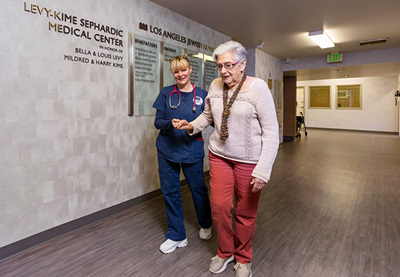
Renovated Clinic Offers Comfort and Community
The Jewish Home's Levy-Kime Geriatric Community Clinic recently received a makeover, including upgraded equipment and amenities.
Located on the Eisenberg Village campus, the clinic provides residents with primary and specialty medical care.
"The medical care we provide is convenient, easily accessible and essential to the well-being of our residents," says Stephen Martinez, Ph.D., executive director of the Levy-Kime Geriatric Community Clinic and the Los Angeles Jewish Home's Independent Practice Association (IPA).
Martinez oversaw the renovation of the clinic, which is open weekdays.
"These renovations are the result of our striving for the highest level of wellness for our residents," he says. "We upgraded to maximize our space and modernized the look of the entire clinic. We went through each room and identified what was needed, whether it was new equipment, lighting or a coat of paint."
In addition, new works of art now adorn the walls of the Clinic, thanks to the efforts of Nancy Katz and Nancy Meshulam, co-chairs of the Jewish Home's Art Committee.
For Dr. Noah Marco, the Home's chief medical officer, the upgrades are a source of pride. "I am so honored to join my clinician colleagues to work in such a healing environment," he says.
Dr. Marco notes that he is particularly proud of the new space for counseling and psychotherapy. Formerly a doctor's office, the room, he says "feels like a living room. It is a relaxing and healing space and has a different feel than most outpatient clinics."
Martinez adds that he's witnessed how the aesthetic improvements have had a psycho-social benefit for the residents.
"Just improving the appearance of the clinic improves the overall satisfaction of our residents and increases their feelings of comfort and community," Martinez says.
Resident Leslie Scales, who recently visited the clinic for a podiatrist appointment, definitely approves of the clinic's refreshed look. "It's lovely," she says. "I especially love the new artwork!"
Above all, however, Scales praises the care she receives at the clinic. "The nurses couldn't be any better. They are so accommodating," she says. "I'm pleased with all of my doctors here and with the care I get."
And that's the payoff Martinez seeks. "It's so satisfying to see the residents go into the clinic and emerge feeling grateful," he says.
Feb
29
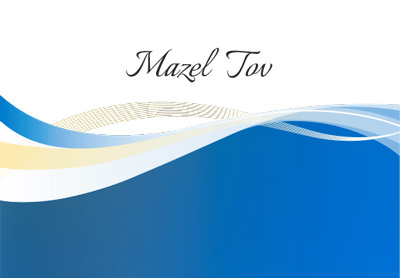
Give the Gift of Love with a Jewish Home Tribute Card
What's the perfect way to brighten a friend or loved one's day and help the Jewish Home at the same time?
A Jewish Home Tribute Card!
With a donation to the Home, you can select from a wide array of themes and personalize a message either online, via phone or mail.
Themes include: "Mazel Tov," "Happy Birthday," "Thank You," or "Get Well." You can also select to honor someone's achievement or memory.
Donations are used to improve and enrich the lives of the seniors in our care. In addition, you can select to direct the funds through one of the Home's Support Groups, which are dedicated to enhancing our residents' quality of life. Directing funds through a support group is especially meaningful if the person you are honoring or celebrating is a member.
Tribute cards are promptly mailed and indicate a donation was made to the Jewish Home.
To order a tribute card, use this link.
You can also call our offices to request a Tribute Card: 818.774.3338, or complete and fax this downloadable form to 818.342.0881.
Feb
17
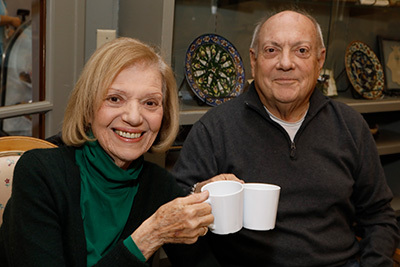
How to Make the Most of Your Retirement Years
If you're heading into your older years, you might be considering retirement. While leaving your work role may feel like you are embarking on a permanent vacation, some people find it a tough transition. It all depends on your mindset.
Researchers have found retirees are happiest when they plan how to spend their time and make the most of it.
Here are some tips for transitioning from a fulfilling work life to a fulfilling life in retirement.
Stay Social
Leaving the workplace doesn't have to mean leaving your social network behind. Indeed, research shows that maintaining strong social networks seems to be linked to slower cognitive decline. So, maintain those workplace friendships, while also enjoying regular lunches or game nights with your "civilian" friends.
Intergenerational relationships are also essential to healthy retirement years. Take some time to get to know your grandkids, nieces and nephews, or the children of family friends. According to Harvard Psychiatrist George Vaillant, "generativity" means investing in, caring for, and developing the next generation. Bonus: Older adults who did so were three times as likely to be happy as those who did not.
Are you more of a homebody? Adopt a pet. Research shows that caring for a pet brings many health benefits, including a sense of purpose, happiness and security.
Expand Your Mind
Studies have shown that lifelong learning can be associated with better memory and cognitive skills, improved mood and better well-being. See if your local university or community college offers learning opportunities. Now's the chance to audit an anthropology course, or delve into oceanography or bioethics. Senior Centers also offer courses in current events and even languages.
Being retired can also mean time to unleash the right-brain and release your creative power. You could explore painting, ceramics or even gardening, which are all beneficial to your emotional well-being,
Another way to expand your vistas is to travel. Travel leads to meeting new people, learning about different cultures and facing fresh challenges.
Maintain Good Fitness
Whether it's scheduling more rounds of golf, tennis matches or walks with friends, it's crucial to your healthy retirement years to find physical activities that you enjoy and to make them a regular part of your week. Here are more details about how to stay fit.
In addition to exercising, eating healthy is also key. As you head into your late 60s, your body changes, as do your nutritional needs. Consult these resources from the University of Wisconsin-Madison for some ideas on developing healthy eating habits.
In addition, maintaining long-term good health means visiting your doctor for regular checkups and screenings, including hearing and vision.
Achieve That Helper's High.
With less time focused on building and sustaining your career, now could be the time to give back.
Depending on your goals—meeting new people, or beautifying your local park—there are plenty of options to choose from.
If you are the type who likes to stay busy, consider helping your alma mater or your favorite nonprofit by actively serving on their board.
Doing good deeds provides a "helper's high," which can help you live a longer and healthier life.
And, a longer and healthier life means more time to enjoy your retirement years!
Feb
17

Healthy Heart Month
In 1963, President Lyndon Johnson declared February to be American Heart Month. The action marked a pivotal point in the nation's approach to addressing cardiovascular disease.
Since then, the number of deaths due to heart disease have declined in the U.S., thanks to advances in research, treatment and public education. Yet, while many advances have been made, heart disease is still the leading cause of death in the U.S. and worldwide.
The good news is that the risk factors for heart disease can be modified with changes in lifestyle habits.
Dr. Noah Marco, the Jewish Home's Chief Medical Officer, says the first step is to "add more steps" to your daily routine. He continues:
At the Jewish Home, our residents are not just encouraged to walk around our beautiful campus, but to also join a variety of classes and group activities. These not only strengthen their hearts; they build their connections to our staff and other residents.
Dr. Marco says the second step is to eat natural whole foods like fruits, vegetables and whole grains. "Here at the Jewish Home, our amazing dieticians and kitchen staff prepare meals that are not just healthy and delicious, they are also kosher!"
Gender Differences
Over the years, there has been an increasing awareness of how the disease affects not only men, but women. The risk factors—e.g., smoking, high cholesterol and blood pressure—remain the same between the genders. However, the differences in how men and women experience a heart attack can differ.
According to the American Heart Association, women's heart attack symptoms can be more subtle, such as shortness of breath, pressure or pain in the lower chest or upper abdomen, dizziness, lightheadedness or fainting, upper back pressure or extreme fatigue. Because these symptoms can be linked to acid reflux or the flu, many women may dismiss them without realizing that they are actually experiencing a heart attack.
Heart-Mind Connection
Physicians are also paying more attention to takotsubo cardiomyopathy, also known as "broken heart syndrome," as more than 90% of reported cases are in women ages 58 to 75. According to Harvard Women's Health Watch, research suggests that up to 5% of women who thought they experienced a heart attack, actually have this disorder.
The syndrome is often brought on by stressful situations and extreme emotions. Symptoms can often feel similar to those of a heart attack. These can include: chest pain, shortness of breath, palpitations, nausea and vomiting. But with the syndrome, there is no evidence of coronary artery obstruction. Instead, the left ventricle of the heart changes shape and increases in size. This weakens the heart muscle and means it doesn't pump blood well.
"Achieving optimal emotional health is a key step to building a healthy heart," says Dr. Marco. "Here at the Home, we've been focused on the emotional health of our residents for a long time. Shortly after someone moves in, we hear how happier and less stressed they are."
Learn more about living a heart-healthy lifestyle.
Jan
20
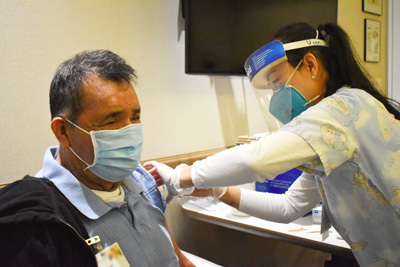
Los Angeles Jewish Home Protects Seniors and the Staff Who Care for Them with COVID-19 Vaccine
All those eligible have received first dose
Two thousand twenty-one is here, and with the rollout of the COVID-19 vaccine at the Los Angeles Jewish Home, hopes are high that this will be an especially happy—and healthy—New Year.
Within weeks after the arrival of the first vaccine shipment, all eligible Jewish Home residents who elected to do so have already received the first dose, says Noah Marco, MD, the Home's chief medical officer. Staff within the government tier groups have also received the vaccine in large numbers. "It's a significant achievement because immunizing residents and staff is helping to protect all those in our care," Dr. Marco says. "For that reason, I have been encouraging every member of the Jewish Home community to follow a simple mantra: 'Don't hesitate; vaccinate!'"
Among the groups who have received the initial dose are residents and staff directly involved in care or service within the Home's skilled nursing facilities including the Joyce Eisenberg-Keefer Medical Center, the Mark Taper Skilled Nursing Building, the Max Factor Family Foundation Nursing Building, and the Goldenberg•Ziman Special Care Center. Residents and staff of Fountainview at Gonda, Fountainview at Eisenberg Village, and the Newman and Weinberg buildings have also been inoculated, as have staff at the Home's Brandman Centers for Senior Care and Skirball Hospice and Palliative Care.
To date, the vaccine has reached more than 1,900 people across Jewish Home campuses, notes Jewish Home President and CEO Dale Surowitz. "We are doing everything in our power to expedite this process and to make sure it runs safely, smoothly, and efficiently," he says. "Working around the clock, we have developed an aggressive schedule for administering the vaccine, while of course following all government and public health mandates."
Implementing vaccine distribution in such a timely manner has been possible thanks to the Jewish Home's deep bench of talented and dedicated staff. In addition to Dr. Marco, the Home has a team of nurse practitioners and other nursing staff administering the shots. Helping to secure the arrival of the vaccine is Compliance Officer Timothy Carlson, who is in constant contact with the Los Angeles County Department of Public Health (Public Health) and others to coordinate the next shipment of the vaccines to the Home.
Offering the vaccine on-site has enabled the Jewish Home to streamline the process, allowing residents and staff to sign up easily and without any roadblocks. This has helped maximize the number of people receiving the vaccine and has given the Jewish Home a critical head start on reaching everyone who relies on its programs and services. As the largest single-source provider of comprehensive senior healthcare services in Los Angeles, the Home serves nearly 4,000 seniors each year.
The Jewish Home's efforts have received positive media coverage, including major outlets such as CNN.com, California Healthline/Kaiser Health News, and KNX 1070 news radio. Their coverage shows that, while other institutions have struggled with vaccine coordination, the Jewish Home continues to make important headway.
"We are focused on providing protection to every member of the entire Jewish Home family," Dale says, "and our steady progress shows we're well on the way to reaching that goal."
Oct
1
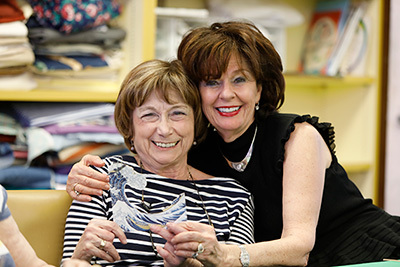
The Value of Volunteering
It takes a village to create a place as special as the Jewish Home. One of the things that makes our village so effective — and so extraordinary — is the high caliber of our dedicated volunteers.
Every year, they donate over 22,000 hours to the Home, assisting with everything from mail delivery and speech therapy, to playing music for residents and facilitating group activities. Their energy and passion infuse the Home with a remarkable spirit that builds community and positively impacts so many seniors' lives.
The value of our volunteers is priceless, and I consider myself fortunate to partner with such an incredible group of individuals. Working together, we are able to serve thousands of elderly men and women in the San Fernando Valley, on the Westside, and across Los Angeles.
Volunteers enrich our programs and services — and they, in turn, are enriched by the time they spend giving back to the Home and to the many other charitable organizations they support. Research shows that volunteering actually makes us feel like we have more time; it helps us to feel loved; it builds important skills and experiences; and it can even keep our bodies healthier. The impulse to volunteer may be philanthropic, but data tells us the benefits are even greater than the investment required.
Albert Einstein noted that we are on this earth for a short visit, not knowing exactly why. Yet, as we make it through the successes and stumbles of daily life, one thing we do know is that we can be here for the sake of each other. By supporting friends and strangers, we make things easier and better for everyone.
Our volunteers understand this well. They join their many hands to spread joy throughout the Home, bringing smiles to the faces of our residents. Every week, I am moved by scenes I see unfolding on our campuses, as volunteers offer the simple gift of love and residents positively glow with happiness.
Whether you are a long-time volunteer or new to the Jewish Home family fold, thank you for your wonderful contributions. If you have not yet experienced the thrill of volunteering, either at the Home or anywhere else, I invite you to give it a try. I can promise you will not regret it.Molly ForrestPresident-CEO
Jul
16
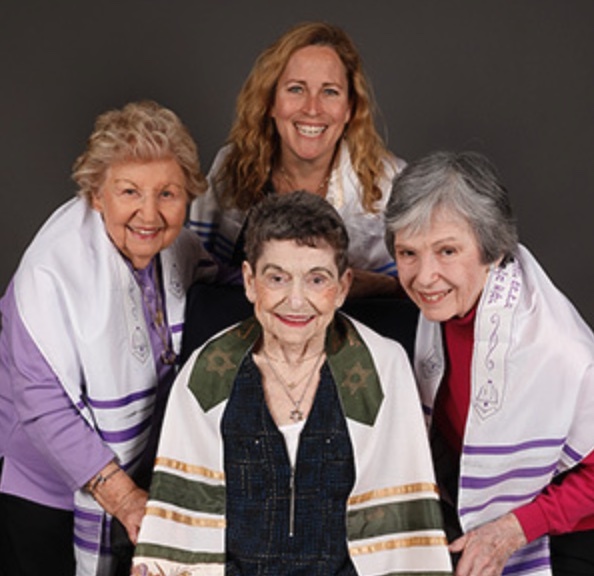
A Milestone for the Ages
The Jewish Home is a destination for Los Angeles-area seniors—an environment offering warmth, caring, compassion, and safety. For many seniors, including Edith Frankie, Linda Frankes, and Mildred Moccio, it is also a point of embarkation: a place from which to set out on exciting journeys of growth and self-discovery. In June, all three women celebrated their adult bat mitzvahs at the Home, culminating a period of intensive preparation and personal exploration.
It was Edith, recalls Rabbi Karen Bender, the Home's Skirball Director of Spiritual Life for the Home's Grancell Village campus, who provided the initial inspiration for the bat mitzvah event. "Edith is a Holocaust survivor, and she had sponsored an honorary bat mitzvah for her six-year-old sister, who never made it out of the camps," Rabbi Bender says. "One day, I suggested she consider having her own bat mitzvah, and she quickly embraced the idea."
From there, Edith picks up the narrative. "I was worried at first because I don't read Hebrew, but Rabbi Bender was very encouraging about how I could learn," she says. "I thought, ‘What a terrific way to get revenge on Hitler: to deepen my understanding of Jewish history and culture!'"
Once Edith was on board, Rabbi Bender extended the offer to her Jewish Home congregants at large. Linda and Mildred stepped up immediately.
"I've always had a deep interest in Judaism, but I grew up during a time when girls were less involved in Jewish religious life, plus my family lived far away from the closest Jewish community," Linda notes. "Now that I'm at the Home, I have time to do what I want to do, and I decided to join Rabbi Bender, Edith, and Mildred every week to learn. It was absolutely wonderful."
Mildred's path to the bimah was different. Earlier this year, at 82 years old, she converted to Judaism from her native Catholic faith in a Jewish Home ceremony led by Rabbi Bender. Her daughter had converted decades earlier, and Mildred ultimately felt the same call. "It took me 82 years to move closer to God, but Judaism has changed my life and way of thinking," she says. With the conversion behind her, she set her sights on a new horizon: gaining something else in common with her 22-year-old granddaughter Payton, who was raised Jewish and had a bat mitzvah at the age of 13.
"My mom and my daughter share an incredible connection, and my mom actually took Payton's Hebrew name during her conversion," says Debbie Doll Breindel, Mildred's daughter. "Now with the bat mitzvah, this whole set of experiences has been so amazing for both of them. I'm incredibly grateful to the Jewish Home for making it possible. My mom living there has been the best thing that's happened to our family."
Edith's son Richard is equally effusive. "My mom has a smile that is always shining, both on her face and in her heart," he says. "Even though she moved into the Home right when she lost my dad—the love of her life for 65 years—and didn't know anyone else, she quickly embraced her life there and started attending services every Friday night and Saturday morning. Her bat mitzvah at the Home is a remarkable accomplishment my wife and I will always treasure, and one that I know my dad would have loved to see."
Edith, Linda, and Mildred's admirers extend well beyond their immediate families. "It was a privilege to attend the b'not mitzvah of these very special Jewish Home residents," says Andrew Berman, chair of the Home's board of directors. "I'm thrilled they were able to experience the joy and fulfillment of this monumental event at this stage of their extraordinary lives."
The women each received a tallit for the occasion, and they wrote divrei torahs (brief commentaries on the weekly Torah portion) to give during the service. Their speeches reflected the insights they gleaned during five months of dedicated study with Rabbi Bender.
"The learning process was so rewarding for these women, and for me," Rabbi Bender says. "It was very touching, and a great honor, to shepherd them through this process. These are people who would probably never have done this in any other setting, but because they're at the Jewish Home, they had the opportunity. It's just incredible."
Rabbi Bender points out that, in addition to engaging in a life-affirming act for themselves, Edith, Linda, and Mildred have also helped blaze a trail for other seniors like them. "The moral of this story is that you can keep stretching and growing at any age," she says. "It's never too late to learn something new."
Apr
10
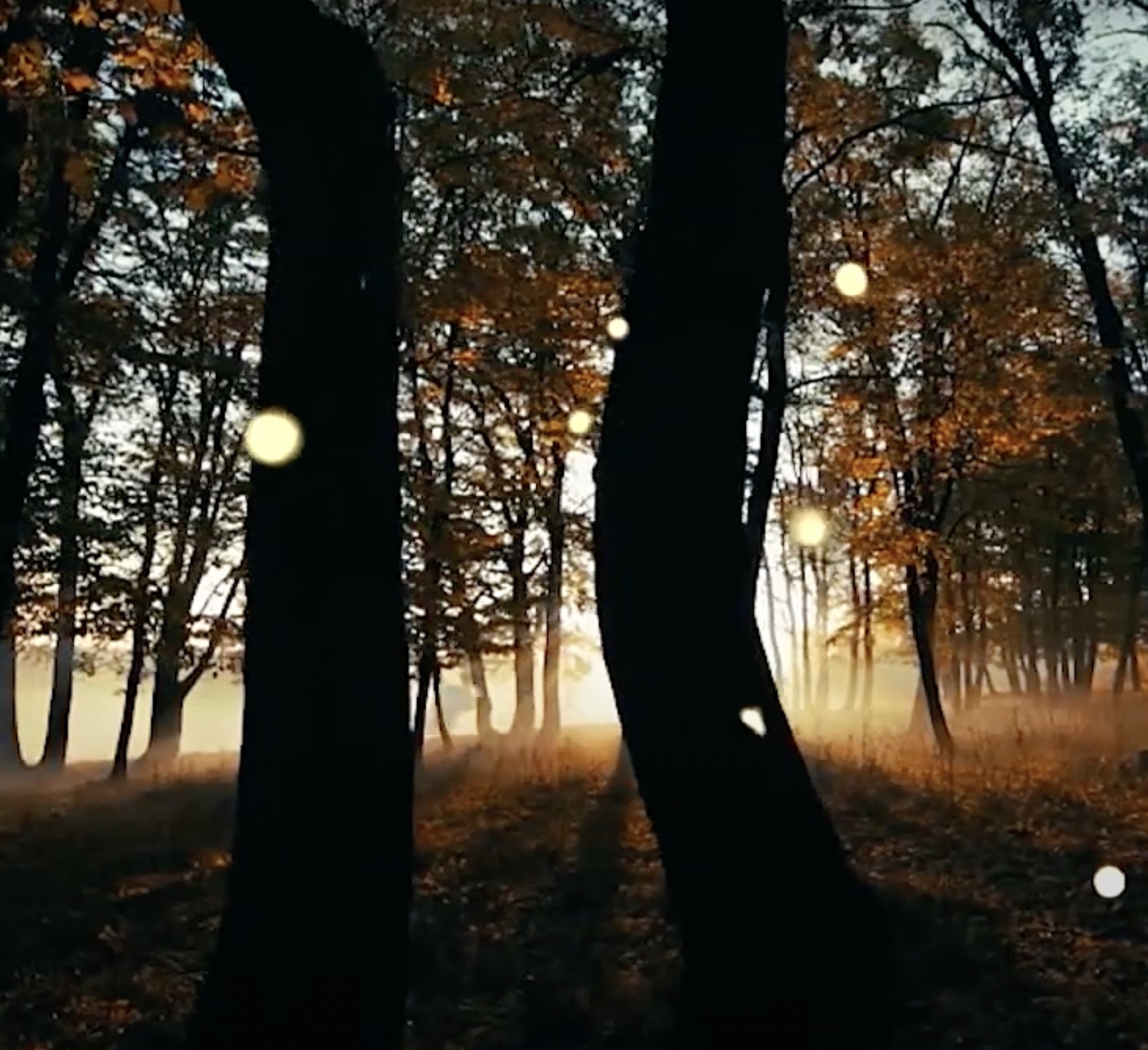
The Beauty of Poetry Runs More Than Skin Deep
April is National Poetry Month, celebrating an artform that can be evocative, challenging, and inspirational. In honor of this month, we filmed three Jewish Home residents talking about their interactions with poetry—how it inspires them and sparks their creativity even when encountered later in life—and reading original works.
An increasing body of evidence documents characteristics of poetry that go well beyond beauty. Indeed, more and more research highlights the positive effects of creative writing on people’s physiological, emotional, and cognitive well-being.
In recent years, scientists have used magnetic resonance imaging (MRI) and other instruments to examine the ways in which poetry affects the human brain. Among their discoveries: When we think about a poem’s meaning, it activates particular parts of our brains – some of the same parts we rely on to interpret our everyday reality.
An article in the highly regarded Harvard Business Review notes that poetry “teaches us to wrestle with and simplify complexity.” As it sparks our creativity, it can also help us foster a deeper sense of empathy, enabling us to understand the feelings and motivations of our family, friends, coworkers, and community members.
Studies show that poems help us in another critical way, too. They cause us to hear words differently and to see them in a fresh light, expanding our ability to use and process language. This stimulates brain function and, ultimately, strengthens brain health.
At the Jewish Home, providing an outlet for creative pursuits like poetry, photography, and music allows seniors to broaden their horizons, to push past mental barriers, and to engage with their peers. Active brains can mean happy lives – seniors excited to learn and to embrace the world around them. Jewish Home staff and volunteers encourage seniors to compose, to paint, or to take up any similar activity that can lift spirits and potentially forge new neural pathways.
The Home is fortunate to count among our residents aspiring poets at all levels of experience. Ellen Meli has been writing poetry since her youth; Nyla Lyon worked in the entertainment business and started experimenting with verse later in life. Both enjoy shaping words and phrases to express themselves, and both see putting pen to paper as stimulating and therapeutic. Their paths to poetry were different, but their conclusions are the same: Creativity can be a blessing at any age.
View Nyla Lyon reading her poem, “The Fireflies’ Glow,” Ellen Meli reading her work titled “How Old?” and Mack Stevens reading an award-winning poem by former resident Shelley Greenspan (of blessed memory) called “See Me With Your Eyes Closed” in three more inspiring videos below.Mack Stevens Reads the Poem “See Me With Your Eyes Closed”Ellen Meli Reads Her Poem “How Old?”Nyla Lyon Reads Her Poem “The Fireflies’ Glow”